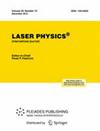Influence of cladding tube structure on transmission characteristics of negative curvature terahertz fiber
IF 1.1
4区 物理与天体物理
Q4 OPTICS
引用次数: 0
Abstract
A novel type of polarization negative curvature terahertz fiber has been designed, which has a cladding region composed of two long semi-circular cladding tubes in the horizontal direction and four long semi-elliptical cladding tubes in the oblique direction. The optimal fiber dimensions are determined to investigate the internal relationship between polarization characteristics and fiber cladding structure. The transmission performances of the negative curvature fiber are investigated by varying the thickness of fiber cladding tubes and adjusting the structural characteristics of cladding tubes in different directions. Relatively good transmission performances can be obtained with a cladding tube thickness of 80包层管结构对负曲率太赫兹光纤传输特性的影响
设计了一种新型偏振负曲率太赫兹光纤,其包层区域在水平方向上由两个半圆形长包层管组成,在倾斜方向上由四个半椭圆形长包层管组成。通过确定最佳光纤尺寸,研究了偏振特性与光纤包层结构之间的内在关系。通过改变光纤包层管的厚度和调整不同方向包层管的结构特性,研究了负曲率光纤的传输性能。包层管厚度为 80 μm 时,可获得相对较好的传输性能。双折射可稳定地保持在 10-4 的数量级,2.55 太赫兹 x 偏振模式的约束损耗为 0.036 dB cm-1。此外,在 2.3-2.6 THz 波段,两个极化模式的色散系数稳定在 ±0.6 ps (THz-cm)-1 之间。此外,还讨论了所设计光纤在 2.52 THz 波段的弯曲性能。结果表明,该光纤的弯曲灵敏度较低,在弯曲状态下仍能保持出色的双折射和较低的约束损耗。对于 y 偏振,在弯曲半径为 10-60 厘米的范围内,双折射可基本稳定在 10-4 的数量级。
本文章由计算机程序翻译,如有差异,请以英文原文为准。
求助全文
约1分钟内获得全文
求助全文
来源期刊

Laser Physics
物理-光学
CiteScore
2.60
自引率
8.30%
发文量
127
审稿时长
2.2 months
期刊介绍:
Laser Physics offers a comprehensive view of theoretical and experimental laser research and applications. Articles cover every aspect of modern laser physics and quantum electronics, emphasizing physical effects in various media (solid, gaseous, liquid) leading to the generation of laser radiation; peculiarities of propagation of laser radiation; problems involving impact of laser radiation on various substances and the emerging physical effects, including coherent ones; the applied use of lasers and laser spectroscopy; the processing and storage of information; and more.
The full list of subject areas covered is as follows:
-physics of lasers-
fibre optics and fibre lasers-
quantum optics and quantum information science-
ultrafast optics and strong-field physics-
nonlinear optics-
physics of cold trapped atoms-
laser methods in chemistry, biology, medicine and ecology-
laser spectroscopy-
novel laser materials and lasers-
optics of nanomaterials-
interaction of laser radiation with matter-
laser interaction with solids-
photonics
 求助内容:
求助内容: 应助结果提醒方式:
应助结果提醒方式:


